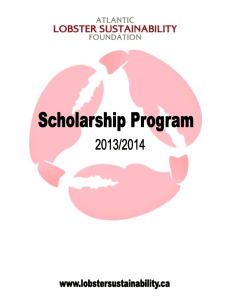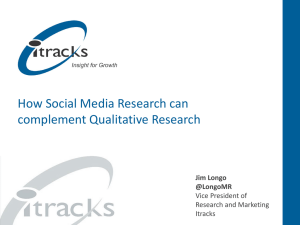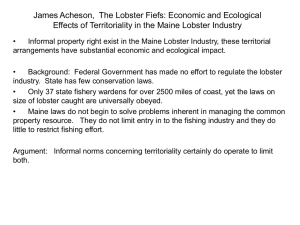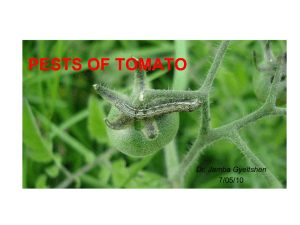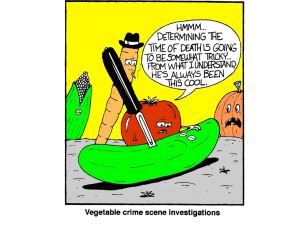Wayne Fairchild - Atlantic Lobster Sustainability foundation
advertisement
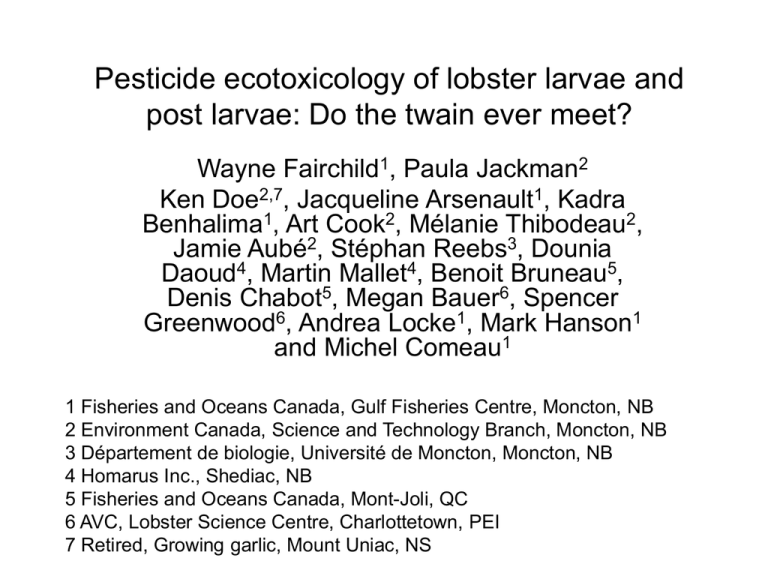
Pesticide ecotoxicology of lobster larvae and post larvae: Do the twain ever meet? Wayne Fairchild1, Paula Jackman2 Ken Doe2,7, Jacqueline Arsenault1, Kadra Benhalima1, Art Cook2, Mélanie Thibodeau2, Jamie Aubé2, Stéphan Reebs3, Dounia Daoud4, Martin Mallet4, Benoit Bruneau5, Denis Chabot5, Megan Bauer6, Spencer Greenwood6, Andrea Locke1, Mark Hanson1 and Michel Comeau1 1 Fisheries and Oceans Canada, Gulf Fisheries Centre, Moncton, NB 2 Environment Canada, Science and Technology Branch, Moncton, NB 3 Département de biologie, Université de Moncton, Moncton, NB 4 Homarus Inc., Shediac, NB 5 Fisheries and Oceans Canada, Mont-Joli, QC 6 AVC, Lobster Science Centre, Charlottetown, PEI 7 Retired, Growing garlic, Mount Uniac, NS Acknowledgements • • • • • • • Fishing Industry through Homarus Inc. Fisheries and Oceans Canada Environment Canada U de Moncton Marine Centre, (Shippagan, NB) Atlantic Cancer Research Institute And many colleagues and students “Oh, East is East, and West is West, and never the twain shall meet” From the The Ballad of East and West, by Rudyard Kipling or … a nice quick summary of the hopes of our regulatory regime and risk assessment process Coastal Habitat – we have a lot of this in Atlantic Canada Today’s Talk Outline • • • • • • • • Objectives Why the concern? Background on pesticides/contaminants What we know about these things? What we don't know? What have we being working on? Surely this is all academic, I mean really? Future directions and research questions Some thoughts and conclusions Little lobsters - Objective • Investigate the potential for pesticides to interfere with the nearshore/estuarine early life stage development of American lobster (Homarus americanus). • Particular emphasis will be placed on high hazard pesticides and pesticides with modes of action that may act at very low concentrations with only transitory exposures. • Given the short length of most PEI freshwater systems, there is a close link between events in rivers and the adjacent salt water. Why a concern to fishing industry? • There was a huge die off of lobster in Long Island Sound that was co-incident with the arrival of West Nile virus • To combat West Nile mosquitoes, an insecticide spray program was initiated around New York (methoprene and others) Was there a link? • Nonylphenol was also found in samples and implicated • Some of the recent workshops are now wondering if a synthetic pyrethroid insecticide could have been a contributor (very potent to FW aquatic invertebrates) • These events have received wide media and industry attention • Can contaminants be a factor (causal, added stress) in the incidence of lobster shell disease? What we know about these things? • contaminants are in many effluent streams (municipal, industrial, agricultural) • Contaminants are mostly below regulated concentrations for regulated endpoints • pesticides are in river runoff, particularly on PEI • new industrial developments, new crops or use patterns, brings new contaminants (or concentrations) to the region What we don't know about? • Nanoparticles (novel behaviours, fresh to salt transition?) • Pyrethroid pesticides, safer but more toxic (effects at very low concentrations) • New chemicals (all classes, 1000s per year) • Particle bound contaminants (fate and effects) • Drugs, personal care products, endocrine disrupting compounds (usually low concentrations, but potential high potency) Contaminant exposure • • • • • • • Spray Drift, direct and indirect Runoff, especially storm events Water, fields to streams to estuaries to ? Particles, from fields or in natural water Sediments, settling or estuarine processes Food, from all sources Plus interactions with environment for all • Figure 3: Transfer of individual larvae into Mason jars. • Figure 4: Lab set-up for Chronic and Acute exposure experiments Environment Canada, Moncton, NB Acute Tests 48-Hour LC50 (as µg/L active ingredient) Pesticide Stage I Stage IV Azinphosmethyl (Guthion) 3.16 (1.00–10.0) Chlorpyrifos (Lorsban) 0.35 (0.27-0.46) Diflubenzuron (Dimilin) > 1000 > 1000 µg/L Endosulfan (Thiodan) 2.51 (1.73-3.64) 3.98 (2.57–6.16) Hexazinone (Velpar) > 1000 > 1000 µg/L Methamidiphos (Monitor) Tebufenozide (Confirm) > 1000 > 1000 > 1000 Pyrethroid formulations of deltamethrin • AMERICAN LOBSTER Homarus americanus • Stage III lobster larvae had acute 96-hr LC50 values between 3.74 to 4.92 ng/L (n = 3). Results for the two formulations over three trials were within a range of 1.2 ng/L (NOTE: units are 1000x lower that previous table) • Stage IV (post larvae) had 96-hr LC50 of 28.2 ng/L. • Stage III lobster larvae given a 1-hr pulse exposure followed by 16 days in clean water had an LC50 of 36.5 ng/L • Chronic exposure of stage III larvae for 16 days had an LC50 of 4.45 ng/L • This pesticide is released into sea water after sea lice treatment, and is in streams from agricultural areas Histological effects of nonylphenol and pesticides on cuticle and hepatopacreatic cells. Legend: Cuticle: Ep (Epicuticle), Ex (Exocuticle), En (Endocuticle), ML (Membraneous layer), Ct (Connective tissue). Hepatopancreas: N (Nuclei), F (Fcell), B (B-cell), L (Lumen), V (Vacuole), Ep (Epithelium). Magnification = 40 X Larval Behaviour Introduction : Metabolism Metabolic rate : most fundamental biological rate as it represents the rate of energy uptake, transformation, and allocation. (Brown et al. 2004) • Standard metabolic Rate (SMR): energy required to maintain basic biological functions independent of activity, digestion or costs of physiological stressors. • Active metabolic rate (AMR): energy required to perform specific levels of activity (< Maximum MR= MMR) • Metabolic scope – absolute MS: difference between SMR and MMR. Energy available to grow, digest food, support locomotion etc. Experimental setup - metabolism • Larvae obtained from Coastal Zones Research InstituteHomarus Inc. hatchery • Acute Exposure stage V-VI - 0.1 μg L-1 - 20 °C, 96-hr • One individual per jar (1 L) to avoid cannibalism, no renewal • Daily feeding of live artemia, frozen artemia, and dry food • Water quality verified daily Results : Metabolic scope Significant difference t2,14 = -2.63 (p = 0.0160) Genomics - Sample Preparation • Sample preservation -Trizol • RNA extraction -Phenol Chloriform • Amplification & labeling -Cy3 & Cy5 • Microarray hybridization Microarray Cluster Analysis Down Regulation 0.01 0.1 0 0.03 0.3 Up Regulation 1.0 0.01 0.1 0 0.03 0.3 1.0 Bugs as food? Lobster larvae and insects in neuston • Insect sampling on land and sea • Is there another great circle of life lesson in the potential for land based sources to affect the near shore marine environment? • Insects are eaten by lobster larvae • After everything, this still surprises me Contents of a neuston sample from the Northumberland Strait. Biota of terrestrial origin sorted to left in pan, marine origin to the right in pan and in sieve. Mayflies on Weather Station Doppler Radar – Lake Erie De http://seagrant.psu.edu/publications/fs/Mayfly_12-2003.pdf Surely this is all Academic? • Leight et al 2005, grass shrimp population monitoring, golf and agriculture, South Carolina, BMP and IPM more shrimp • Hartwell 2011, Chesapeake Bay, mysid relative pesticide toxicity (esp. pyrethroids) and crab harvest, total pesticide application there in range of PEI totals • Baldwin et al 2009, Chinook salmon population modelling, population effects from sublethal pesticide effects, including growth Little lobster - Conclusions • Toxicological screening of pesticides of concern in our region has generated a number of significant results for biological effects on lobster larvae • In our limited screening we have seen compounds that affect survival, moulting, timing of development, histology and behaviour • The high end of test concentrations for most chemicals are above the expected environmental concentrations, effects on lobster larvae running down into the low µg/L (ppb) range and below 1 µg/L are a concern • There is potential for movement of these chemicals into coastal waters, though the pathways and likelihood of such an occurrence remain to be determined Little lobster – Conclusions (cont.) • While there is nothing definitive to indicate a link between lobster population levels, and contaminants in the environment, there is certainly enough information now available to ask good questions (which ironically?) • Microarray analyses are being conducted to study the gene expression changes that occur following exposures of lobster larvae to nonylphenol and pesticides. • The intent is to correlate these changes with effects on survival, growth, moulting, cell histology and behaviour. • A library of contaminant response in the laboratory will be developed to test against field collected larvae to verify exposure. What the research opportunities/needs are? • Linking contaminants and biological effects in real world context. Field studies? Lab-field studies? Linked to biological monitoring? Mixtures? • Below regulated concentrations, but does this mean no biological effects? • Fate of current use contaminants in the environment. Are contaminants accumulating in unexpected reservoirs? • Fate of some degradation resistant pesticides (ex: endosulfan). Are these in decline and “gone” as much as we would like to think? • Estuaries are great chemistry experiments in progress. • … Some thoughts, and conclusions? • Nutrients and sediments, can be good surrogates for occurrence of some groups of contaminants, integration of projects on these topics might provide good synergies • Biological effects approaches may provide an indication of differences in ecosystem health that may go “non-detected” with a chemical measurement approach Questions? Sagittal section of the stereomicroscopy micrographs showing the general view of internal anatomy with the positions the organs of stage IV larval lobster (E: Eye, G: Gill, H: Heart, He: Hepatopancreas, M: Muscle, CS: Cardiac stomach).


